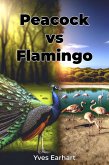The book progresses logically through three main sections, beginning with evolutionary history before examining physical characteristics, habitat preferences, and dietary patterns. Readers learn how moose, with their distinctive shoulder humps and preference for boreal forests, differ fundamentally from elk, which sport a more compact build and adapt to diverse environments from mountains to grasslands. Particularly intriguing is the contrast between moose's browsing habits in wetland environments and elk's grazing tendencies across varied terrains.
While maintaining scientific accuracy, the text remains accessible to general readers, incorporating practical applications for wildlife enthusiasts, photographers, and outdoor professionals. The book extends beyond pure biology to explore these animals' roles in indigenous cultures and modern conservation challenges, making it a valuable resource for understanding both species' places in North American ecosystems. Current research on climate change impacts and habitat conservation adds contemporary relevance to this thorough species comparison.
Dieser Download kann aus rechtlichen Gründen nur mit Rechnungsadresse in A, B, BG, CY, CZ, D, DK, EW, E, FIN, F, GR, H, IRL, I, LT, L, LR, M, NL, PL, P, R, S, SLO, SK ausgeliefert werden.









